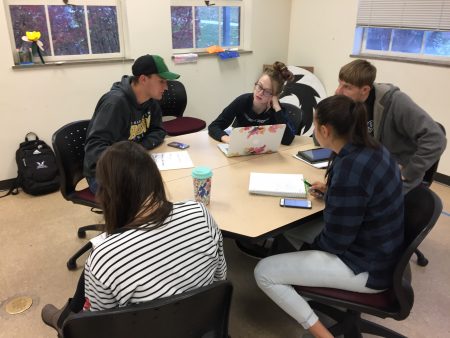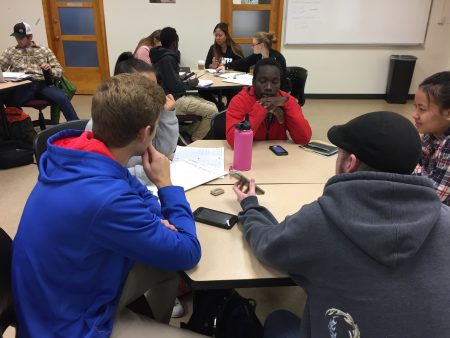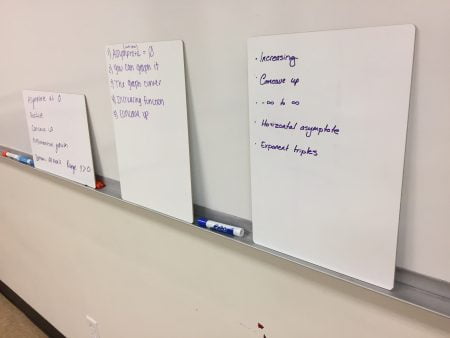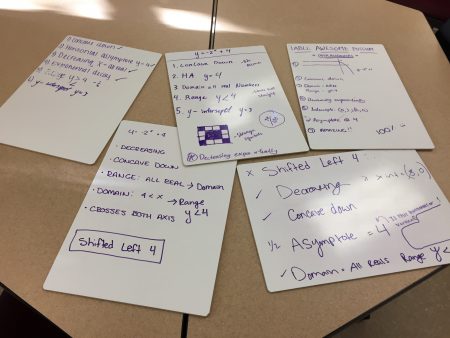
I am often asked how to get learners to spend more time “exploring” in their learning rather than just recalling or responding to specific prompts for information. Exploration of the learning space is particularly important because learners find the interesting nooks and crannies of the concepts that they would not otherwise discover.
Let me share an example. Yesterday in class we needed to spend more time on exponential functions. I began class by displaying a graph of y=2^x and asking the class specific questions like “The graph of an exponential function has an asymptote, where is it?” Only to receive blank stares. It is, after all, an 8am class and this was the first question of the day.
So, I immediately shifted the activity to something that would result in more interaction between students.
I passed out one lap-sized whiteboard to every group and told them to write down at least 5 properties of the graph of y=2^x on the whiteboard.


After 5 minutes, each group would bring their board to the front of the room and display them on the board ledge so we could see (collectively) what we could say about this function. Immediately, the room dynamic changed. Now the students were working towards a common shared purpose – not recording notes on a piece of their own paper, but getting their ideas to a shared board and asking each other whether this or that would be considered a property worthy of inclusion.

At the end of 5 minutes, the students had come up with the following properties:
- Always increasing
- Always Concave up
- Domain is all real numbers
- Range is y>0
- Horizontal asymptote at y=0
- Passes through the point (0,1), which is also the y-intercept
- Does not have an x-intercept
- Exponential growth function
- Always positive
So now, on a roll, I asked the groups to perform the same activity with a new function. Tell me at least 5 properties of y=-2^x+4. This problem goes a bit faster, and includes some new properties in it (like how the graph is shifted from y=2^x).
Instead of sharing with the class right away, I then asked each group to pass their whiteboard to the next group and grade the properties provided by the previous group.
- check mark if correct
- 1/2 if not enough for full credit
- x if incorrect
This now forces the student to reflect on whether what they write is accurate enough or “enough” to be a property. For example is saying “the asymptote is 4” enough to receive full credit? Most groups end up marking this as wrong or 1/2 credit because it is not clear whether 4 is a horizontal or vertical asymptote. This gives the students a chance for metacognitive reflection on the properties that they might write in the future.

Once the groups are done grading, I ask them to add a property to the whiteboard they currently have. Then we share the boards at the front of the room and discuss both the grading and the new properties we see.
Incidentally, I really like putting these kinds of exploration questions on exams. It is a chance for students to show off what they do know instead of me poking around at what they might not know. Often when I ask for 5 properties, I get more than 5 in return.
Here are some variations on this type of group activity that you could use in math:
- Solve this problem showing as many steps that make sense as you can think of
- Solve this problem in as many ways as possible
- Show at least two ways you can check this problem
- Solve this problem. (wait till all groups are done) Now tell me two interesting things about the problem or the math involved in the problem.
- Tell me 5 properties of this function.
- Tell me 5 properties of this graph (giving the students a graph with no function attached).
- Without solving this word problem, list 5 things you know about the problem.
Ways to make the group activities more interesting:
- bring the boards to the front of the room to force each group to be accountable to actually having results
- pass the board from group to group, asking each group to add something to what the previous group wrote
- pass the board to the next group for grading
- give out a different problem, graph, or function to each group, then pass them from group to group to add properties (several times) and then grade the final result (this way students see a slightly different problem with each board shift)
To summarize, there are two main points to the activities here: 1. increase the amount of interaction around the math and 2. explore the problem space of the math instead of simply recalling when asked for a specific fact.
Could you do this in other subjects? Sure!
- Tell me 5 things that led to the start of WWII.
- Tell me 5 nutritional challenges that affect those with heart disease.
- Tell me 5 sentences of greeting that could be used when greeting someone in Spanish.
- Tell me all the things you should do when greeting a new patient.
- Tell me 5 reasons why people don’t vote in elections.
- Tell me 5 things that have to happen before a bill becomes a law.



